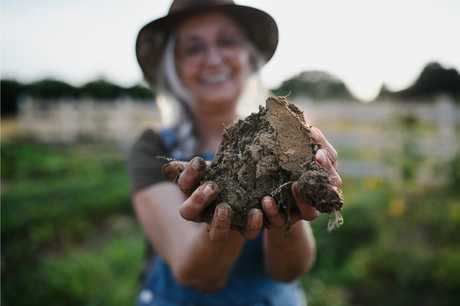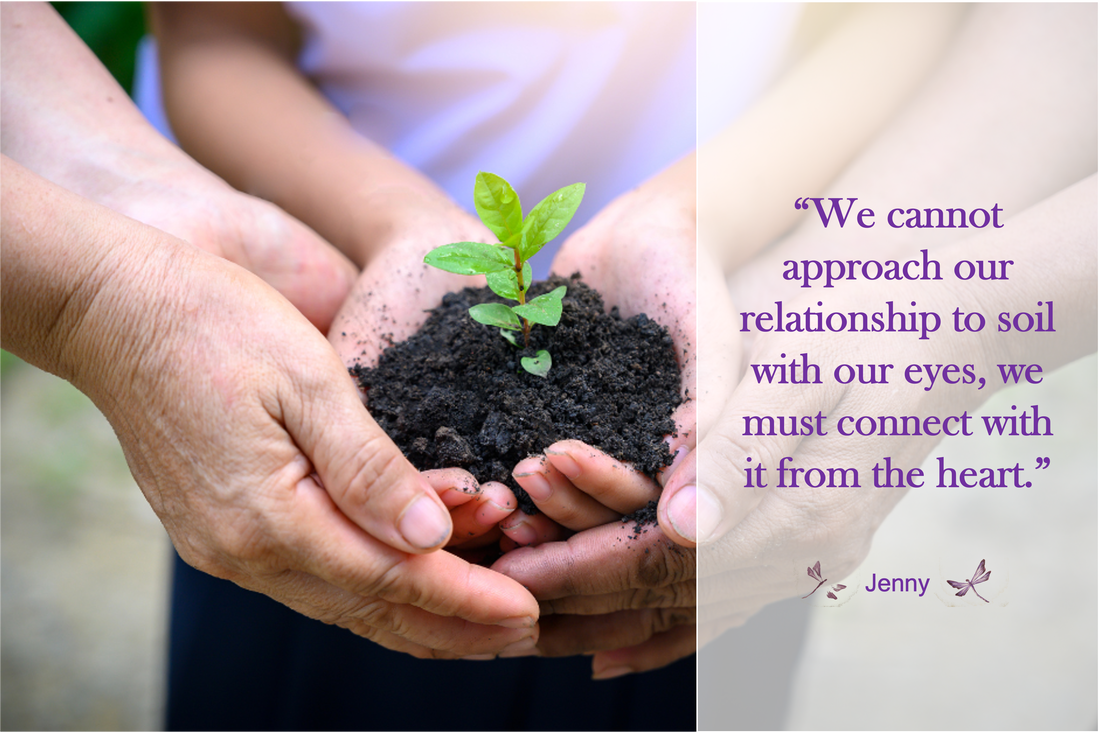
The Story of Soil: What It Is, What It Isn’t, and Why You NEED to Protect Soils on Your Property9/11/2023  All life on land depends on soil. Even yours! Humans cannot live without soil, just as we cannot live without water and air. Soil grows our food, filters our water, and provides us with medicine. It performs seemingly magical services that support the lives of every terrestrial organism on Earth. According to Jerry Hatfield, Director of the USDA National Lab for Agriculture and the Environment, “What we eat, other than what comes out of the oceans, is all derived from soil. Soil security is equal to food security.” And yet we walk on soil all day, every day, paying it no mind and taking it for granted. We confuse soil with dirt and fail to recognize the monumental distinction. Worse even, we’ve been taught to perceive soil as a pollutant with government regulations encouraging its demise. In this eighth post of the Regenerative Design series, I offer a shift in perspective of soil so that we may understand its life-supportive role. Without this shift, our hopes for soil conservation are as dead as dirt. Soil is Alive. Dirt is Dead. Soil is teeming with life! Healthy soils contain an entire food web that’s more biologically diverse and concentrated than life in a jungle. According to Kathy Merrifield, at Oregon State University “A single teaspoon of rich garden soil can hold up to one billion bacteria, several yards of fungal filaments, several thousand protozoa, and scores of nematodes.” There are more living organisms in one handful of soil than there are people in the world! The billions of organisms that make up the soil food web perform services that allow for life on Earth! These tiny, unseen magicians play a MUCH bigger role than we give them credit for. Nitrogen-fixing bacteria and single-celled protozoa are responsible for making nitrogen available to plants. Mycorrhizae (explained further in the last blog) are responsible for aiding in plant nutrient uptake as well as playing a role in keeping atmospheric carbon locked up in the soil. In fact, all carbon-based lifeforms in the soil are responsible for the massive carbon sequestration abilities of soil, without which our atmosphere would not be livable. Without these organisms, plants would die and without plants, all other organisms on Earth would die. We owe our existence to soil! As one of Earth’s largest reservoirs of biodiversity, soil contains almost one-third of ALL the planet’s life. This is astonishing considering most of the biological activity is in the topsoil layer, which is typically only 2-8 inches deep! All this life, in such a thin and vulnerable layer of land. Life that supports life! Dirt, on the other hand, is dead. A sterile substrate that does not support life. Dirt is a subset of soil, and though soil contains some dirt, soil also contains minerals, organic matter from decomposing plants and animals, water, and air. When soil is destroyed and stripped of its life-supporting constituents, it is reduced to dirt. Dirt contains sand, silt, clay, and rock. It does not contain the elements required to support life. Dirt does, however, support our buildings. Your property needs to be excavated and graded before it can properly support the foundation of your home. This process removes all the plant life and topsoil required to create a level and sturdy surface on which to build your home. However, all too often we throw the baby out with the bathwater, and that precious layer of topsoil, teeming with life, gets disregarded as if it were lifeless dirt. Just because it looks like dirt does not mean it should be treated as dirt. We cannot approach our relationship to soil with our eyes, we must connect with it from the heart. If we acknowledge the difference between soil and dirt, we could possibly honor soil and all that it does to support life on Earth. This recognition is how we shift from a passive bystander to assuming an active position of power and insisting that topsoil be preserved on EVERY construction site. How Are Soils on a Construction Site Destroyed? Before you can effectively save soils you first must understand the different ways soils are typically degraded. There are essentially two main ways soils are destroyed during the home construction process: 1. Compaction 2. Erosion & Sedimentation Compaction kills soil by reducing the pore size between particles. Without access to oxygen and water, the billions of beneficial, aerobic organisms that live in the soil die. This reduction of pore size between soil particles also reduces the soil’s ability to absorb water which is one of soil’s leading benefits! Healthy soils readily absorb, filter, and clean our water! Compacted soils cannot hold or filter water which starves plants and leads to an increase in erosion. Compaction occurs in the very first pass of heavy machinery! It’s not enough to limit the amount of traffic from construction vehicles. All it takes is just one pass of a truck for soil compaction to take place. For this reason, it’s imperative to keep all machinery out of areas designated for soil preservation, like the Tree Protection Zones discussed in the last blog. Wet soils have an even greater potential to compact topsoil layers. Erosion is the act of soil removal by wind and water. Sedimentation is the deposition of those eroded soils into water bodies or onto other land surfaces. The magic of soil can only occur when it stays in place, ON the land, in its natural habitat. Erosion and sedimentation remove nutrients and the billions of organisms native to that area and deposits them into an environment where they cannot thrive or are potentially harmful to other life forms. When vegetation is removed from a homesite and bare soil is exposed to the elements, it’s easily displaced by wind or moving water. One heavy rain can wash a tremendous amount of soil off a construction site if that soil is not protected. Erosion on a construction site is inevitable! Soil as a Pollutant? Because erosion is inevitable, most states have regulations requiring an Erosion & Sediment Control (E&SC) plan as part of the excavation and building process. However, erosion control agencies only view soil as a pollutant. Their myopic mission is to keep excess soils out of watershed areas, and for good reason. Displaced soils in watersheds cause a chain reaction that degrades the health of fish and other aquatic species. In reference to lakes, rivers, streams, and oceans, excess soil is bad. Note: Erosion and sedimentation are very normal actions of the natural world. It’s only when human activity and development create disturbances that cause an excess of soils to enter the watershed that soils can be perceived as a pollutant. There are dangers in perceiving soil this way. When we look at soil as the bad guy, it’s treated even worse than dirt. On a typical construction site, most soil scraped from the land is removed entirely. Trucked off-site to be disposed of as if it were trash. Any remaining soils are pounded and compacted firmly to prevent them from easily being carried away by wind and water or to be used as fill dirt. This compaction kills what soil remains and renders it lifeless. There are penalties that a builder (or homeowner) must pay if their construction site does not adhere to erosion control laws. So, it behooves a builder to get rid of or compact the soils from excavation to prevent excessive erosion and sedimentation. Regulating bodies inadvertently pressure builders to also perceive soil as pollution and because there are not laws in place for protecting soils on a build site, it’s easy to turn a blind eye to the destruction of soils taking place. It’s more work and requires more space to conserve soils. According to the builders we know and love, many homeowners want to maximize their building envelope which leaves little or no room for storage of soils on site. Soils cannot be stored on a septic field or in buffer zones. And so, the construction site is designed with space to stage materials, but not soils. How can we shift our perspective so that we recognize the importance of both: materials to build the home and soils to build the environment? We need both! And the only one who has the power to insist that both are planned for is YOU! This makes YOU, the homeowner, the responsible party for making sure the soils on your property are saved and protected! That’s a heavy responsibility, though don’t worry, we’re here to help guide you to the right people who can help you develop a regenerative plan you feel good about. Join us next time when we explain what the current rules and regulations are in NC for clearing land with suggestions for how we can do better to save our soils. I intend you see soil with your heart, as a valuable resource that supports all life! Supportive of you, Jenny Pippin, CPBD, FAIBD, CGP
0 Comments
Leave a Reply. |
AuthorI am Jenny Pippin, founder of Pippin Home Designs and creator of my own inspired living. I grew up as an ordinary southern girl, working in the fields of my family’s tobacco farm. It didn’t take me long to realize I had greater gifts and so I chose to step into my power and create my own path in life, inspired by my heart’s true passion. (More on my personal story HERE!) Archives
February 2024
Categories
All
|
Copyright 2020. Pippin Home Designs. All rights reserved.
ARCHITECTURAL DESIGN COPYRIGHT NOTICE
1987-2024 Copyright. Jennifer B. Pippin FAIBD, CPBD. Pertaining to all home designs, drawings, and photographic imagery of completed designs
presented herein. No part of the contents of the design work presented on this website may be reproduced or transmitted in any form or
by any means, electronic or mechanical, for the purpose of replication or adaptation. This material is intended to provide accurate and
authoritative information about the design abilities and expertise of Jennifer B. Pippin FAIBD, CPBD and Pippin Home Designs.
ARCHITECTURAL DESIGN COPYRIGHT NOTICE
1987-2024 Copyright. Jennifer B. Pippin FAIBD, CPBD. Pertaining to all home designs, drawings, and photographic imagery of completed designs
presented herein. No part of the contents of the design work presented on this website may be reproduced or transmitted in any form or
by any means, electronic or mechanical, for the purpose of replication or adaptation. This material is intended to provide accurate and
authoritative information about the design abilities and expertise of Jennifer B. Pippin FAIBD, CPBD and Pippin Home Designs.






 RSS Feed
RSS Feed
